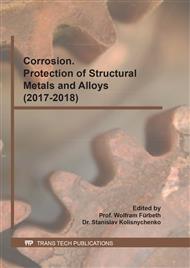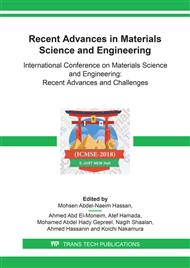p.98
p.104
p.119
p.128
p.134
p.149
p.159
p.165
p.174
Some Anionic Surfactants as Corrosion Inhibitors for Carbon Steel in Hydrochloric Acid Solution
Abstract:
The corrosion inhibition effect of some anionic surfactants (Diisononyl phthalate (A), N-oleyl-1, 3-propane –diamine (B), and Sodium lauryl sulphate (C)) on the corrosion of carbon steel in 1M hydrochloric acid solution were studied by chemical method (weight loss) and electrochemical methods (potentiodynamic polarization and electrochemical impedance spectroscopy (EIS). From the results, it was clear that these surfactants are good inhibitors for corrosion of carbon steel in 1M HCl solution. Their inhibition depends mainly on their concentrations and temperature of solution. Polarization data revealed that these surfactants act as mixed type inhibitors. The surfactants adsorptions were found to follow Langmuir’s adsorption isotherm. The thermodynamic parameters of activation and adsorption were calculated and discussed. Adsorption of used surfactants led to a reduction in the double layer capacitance (Cdl) and an increase in the charge transfer resistance (Rct). All measurements used confirmed the adsorption of the surfactants used on carbon steel surface. Confirmation of these various independent techniques proved validity of the obtained data.
Info:
Periodical:
Pages:
134-148
Citation:
Online since:
October 2018
Authors:
Keywords:
Price:
Сopyright:
© 2018 Trans Tech Publications Ltd. All Rights Reserved
Share:
Citation:



